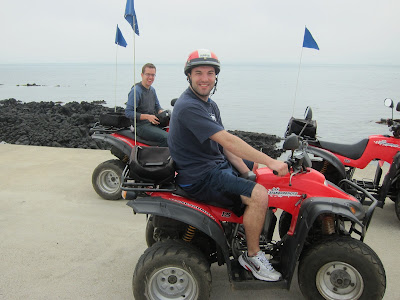Two years ago this week I found myself with some time off thanks to one famous fat man's reputed birthday, Labour Day and Children's Day all coming together in one brilliant weekend stretch. A four day weekend meant we couldn't go too far, but a four day weekend meant we had to go somewhere! So my friends Pauline and Oliver and I decided to take a run down to Jeju-do, or "The Hawaii of Korea."
We decided to circle the island, landing at the northern city of Jeju-si and heading west. Oliver had just dislocated his shoulder so Pauline and I were carrying our gear and half of his on our backs, freeing up Oliver to become our unofficial photographer (full disclosure: all of these pictures are his). On the second day we had made it to Seogwipo-si, Jeju's other city on the southern coast. Seogwipo was the home of some of Pauline's friends who were willing to host us, and with their help and their wheels, we got to cross off most of the southern half of the island.
It took about thirty minutes to walk around the stone path that circled Mara-do, taking in the lonely lighthouse and the few restaurants catering to day-trippers like us. I even had a chance to play keep-up on possibly the most remote football pitch I've ever seen. When it was time to leave the spectacular black cliffs of volcanic rock behind, we made our way to the ferry. There, floating in the water next to the ferry, was a gaggle of grandmothers! Grandmothers! Jeju-do has a matriarchal family structure with one unique detail: as the breadwinners of the family, women known as Haenyo (해녀) earn their living by diving for seafood. Free diving in cold water with no scuba gear, purportedly to depths of 20 meters, to find conch and abalone. Oh, and they can hold their breath for up to two minutes. Picture your grandmother. Now picture her 20 meters deep sawing off shellfish with a rusty knife!
It felt like there was something beautiful to see for every hour of the day. We stopped at Ju-moon beach and Cheonjiyeon waterfall, both beautiful examples of Jeju's rugged range of sights. We rented ATV's on another small island just off the coast of Jeju. Rampaging around, tearing through farmland and quiet country lanes, there was something in it that captured Jeju's scene. A beautiful island with a grab-bag of touristy experiences scattered around, not yet over-crowded with kitschy attractions but getting close.
On our final morning, we woke up in a minbak (민박) on the east coast of Jeju near the famous Seongsan-Ilchulbong. Seongsan-Ilchulbong, or "Sunrise Peak," is a massive volcanic tuff cone that rises out of the sea like an ancient citadel. It is a mountainous plateau with a crater on the top that is blanketed with lush green meadows, making it one of the crown jewels of Jeju's tourist industry. We rose with the dawn and climbed the pulse-pounding 182 meters to the top to take in the beautiful sight... ...of grey fog. We kept thinking that it would lift at the top, but it just never did. I'll have to keep wondering what is in that crater!
Looking back on Jeju, it has to be one of my favorite weekend trips that I've taken. Foggy crater aside, it was great friends and great memories: we managed to hike cliffs and mountains, see caves and waterfalls, explore three islands and a lava tube, amble through beautifully decorated temples and of course, eat great food.
.JPG) |
| Miss you guys! |
.JPG)
.JPG)

.JPG)
.JPG)







.JPG)

.JPG)

.JPG)
